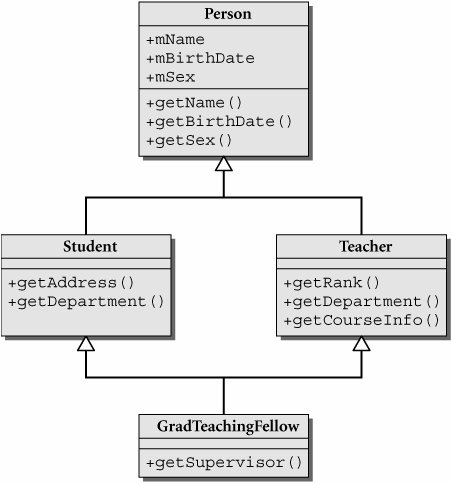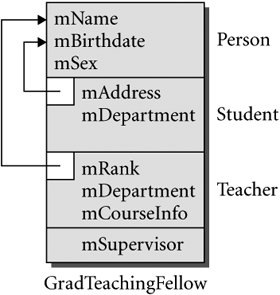Multiple Inheritance
Point of Departure
Multiple inheritance with QObject is discussed further in Qt Quarterly.[3]
[3] http://doc.trolltech.com/qq/qq15-academic.html#multipleinheritance
.3.3. Resolving Multiple Inheritance Conflicts
Figure 23.4 shows a UML diagram where multiple inheritance is being used incorrectly, for both interface and implementation. To make things even more complicated, we are inheriting from the same base class twice.
Figure 23.4. PersonStudentTeacher

Here, the class GradTeachingFellow is derived from two classes: Student and Teacher.
class GradTeachingFellow : public Student,
public Teacher {
// class member functions and data members
};
Name conflicts and design problems can arise from the improper use of multiple inheritance. In the above example, geTDepartment() function exists in both Student and Teacher. The student could be studying in one department and teaching in another, for example.
![]()
What happens when you call geTDepartment() on a GraduateTeachingFellow?
GraduateTeachingFellow gtf; Person* pptr = >f; Student * sptr = >f;; Teacher* tptr = >f; gtf.Teacher::getDepartment(); gtf.Student::getDepartment(); sptr->getDepartment() tptr->getDepartment() pptr->getDepartment(); // ambiguous - run-time error if virtual gtf.getDepartment(); // Compiler error - ambiguous function call
The problem, of course, is that we have provided no getdepartment() function in the GradTeachingFellow class. When the compiler looks for a geTDepartment() function, Student and Teacher have equal priority.
Inheritance conflicts like these should be avoided because they lead to much design confusion later. However, in this case they can also be resolved with the aid of scope resolution.
.3.3.1. virtual Inheritance
In Figure 23.4, we inherited more than once from the same base class. There is another problem with that model: redundancy. When we create instances of this multiply inherited class, they might look like Figure 23.5.
Figure 23.5. GradTeachingFellownonvirtual

Person has attributes that we wish to inherit only once. It makes no sense for a GradTeachingFellow to have two birthdates and two names. virtual inheritance allows us to avoid the redundancy.
The strange problems that can arise when multiple inheritance is used in controversial ways, especially with the added complexities of virtual versus nonvirtual inheritance/functions, seem to have prompted the designers of Java to exclude multiple inheritance from their language. Instead, Java allows the programmer to define an interface, which consists only of abstract (pure virtual) functions. A Java class can then use the implements clause to implement as many interfaces as it needs.
.3.3.2. virtual Base Classes
A base class may be declared virtual. A virtual base class shares its representation with all other classes that have the same virtual base class.
Add the keyword virtual in the classHead as shown in Example 23.8, leaving all the other details of the class definitions the same.
Example 23.8. src/multinheritance/people.h
#include "qdatetime.h"
class Person {
public:
Person(QString name, QDate birthdate)
QObject(name.ascii()),
m_Birthdate(birthdate) {}
Person(const Person& p) : QObject(p),
m_Birthdate(p.m_Birthdate) {}
private:
QDate m_Birthdate;
};
class Student : virtual public Person { <-- 1
// other class members
};
class Teacher : virtual public Person { <-- 2
// other class members
}
class GraduateTeachingFellow :
public Student, public Teacher { <-- 3
public:
GraduateTeachingFellow(const Person& p,
const Student& s, const Teacher& t):
Person(p), Students(s), Teacher(t) {} <-- 4
}
|
After using virtual inheritance, an instance of GradTeachingFellow might look like Figure 23.6.
Figure 23.6. GradTeachingFellowvirtual

Each instance of a class that virtually inherits from another has a pointer (or a variable offset) to its virtual base class subobject. The virtual base class pointer is invisible to the programmer and, in general, not necessary to change.
With multiple inheritance, each virtual base class pointer points to the same object, effectively allowing the base class object to be shared among all of the derived-class "parts."
For any class with a virtual base among its base classes, a member initialization entry for that virtual base must appear in the member initialization for that class. Otherwise, the virtual base gets default initialization.
Review Questions
| 1. | What is a vtable? |
| 2. | What is a polymorphic type? |
| 3. | Which kinds of member functions are not inherited? Why? |
| 4. | Under what circumstances should we have virtual destructors? |
| 5. | What happens when a virtual function is called from a base-class constructor? |
| 6. | What is virtual inheritance? What problems can it be used to solve? |
| 7. | Why would one use non-public derivation? |
Part I: Introduction to C++ and Qt 4
C++ Introduction
- C++ Introduction
- Overview of C++
- A Brief History of C++
- Setup: Open-Source Platforms
- Setup: Win32
- C++ First Example
- Input and Output
- Identifiers, Types, and Literals
- C++ Simple Types
- C++ Standard Library Strings
- Streams
- The Keyword const
- Pointers and Memory Access
- const* and *const
- Reference Variables
- Points of Departure
- Review Questions
Classes
- Classes
- Structs
- Class Definitions
- Member Access Specifiers
- Encapsulation
- Introduction to UML
- Friends of a Class
- Constructors
- Subobjects
- Destructors
- The Keyword static
- Copy Constructors and Assignment Operators
- Conversions
- const Member Functions
- Review Questions
Introduction to Qt
- Introduction to Qt
- Example Project: Using QApplication and QLabel
- Makefile, qmake, and Project Files
- Getting Help Online
- Style Guidelines and Naming Conventions
- The Qt Core Module
- Streams and Dates
- Points of Departure
- Review Questions
Lists
Functions
- Functions
- Function Declarations
- Overloading Functions
- Optional Arguments
- Operator Overloading
- Parameter Passing by Value
- Parameter Passing by Reference
- References to const
- Function Return Values
- Returning References from Functions
- Overloading on const-ness
- Inline Functions
- Inlining versus Macro Expansion
- Review Questions
Inheritance and Polymorphism
- Inheritance and Polymorphism
- Simple Derivation
- Derivation with Polymorphism
- Derivation from an Abstract Base Class
- Inheritance Design
- Overloading, Hiding, and Overriding
- Constructors, Destructors, and Copy Assignment Operators
- Processing Command-Line Arguments
- Points of Departure
- Review Questions
Part II: Higher-Level Programming
Libraries
- Libraries
- Code Containers
- Reusing Other Libraries
- Organizing Libraries: Dependency Management
- Installing Libraries: A Lab Exercise
- Frameworks and Components
- Review Questions
Introduction to Design Patterns
QObject
- QObject
- QObjects Child Managment
- Composite Pattern: Parents and Children
- QApplication and the Event Loop
- Q_OBJECT and moc: A Checklist
- Values and Objects
- tr() and Internationalization
- Point of Departure
- Review Questions
Generics and Containers
- Generics and Containers
- Generics and Templates
- Containers
- Managed Containers, Composites, and Aggregates
- Implicitly Shared Classes
- Generics, Algorithms, and Operators
- Serializer Pattern
- Sorted Map Example
- Review Questions
Qt GUI Widgets
- Qt GUI Widgets
- Widget Categories
- QMainWindow and QSettings
- Dialogs
- Images and Resources
- Layout of Widgets
- QActions, QMenus, and QMenuBars
- QActions, QToolbars, and QActionGroups
- Regions and QDockWidgets
- Views of a QStringList
- Points of Departure
- Review Questions
Concurrency
- Concurrency
- QProcess and Process Control
- Threads and QThread
- Summary: QProcess and QThread
- Review Questions
Validation and Regular Expressions
- Validation and Regular Expressions
- Validators
- Regular Expressions
- Regular Expression Validation
- Review Questions
Parsing XML
Meta Objects, Properties, and Reflective Programming
- Meta Objects, Properties, and Reflective Programming
- Anti-patterns
- QMetaObject: The MetaObject Pattern
- Type Identification and qobject_cast
- Q_PROPERTY Macro: Describing QObject Properties
- QVariant Class: Accessing Properties
- DataObject: An Extension of QObject
- Property Containers: PropsMap
- Review Questions
More Design Patterns
- More Design Patterns
- Creational Patterns
- Serializer Pattern Revisited
- The Façade Pattern
- Points of Departure
- Review Questions
Models and Views
- Models and Views
- M-V-C: What about the Controller?
- Dynamic Form Models
- Qt 4 Models and Views
- Table Models
- Tree Models
- Review Questions
Qt SQL Classes
Part III: C++ Language Reference
Types and Expressions
- Types and Expressions
- Operators
- Evaluation of Logical Expressions
- Enumerations
- Signed and Unsigned Integral Types
- Standard Expression Conversions
- Explicit Conversions
- Safer Typecasting Using ANSI C++ Typecasts
- Run-Time Type Identification (RTTI)
- Member Selection Operators
- Point of Departure
- Review Questions
Scope and Storage Class
- Scope and Storage Class
- Declarations and Definitions
- Identifier Scope
- Storage Class
- Namespaces
- Review Questions
Statements and Control Structures
Memory Access
- Memory Access
- Pointer Pathology
- Further Pointer Pathology with Heap Memory
- Memory Access Summary
- Introduction to Arrays
- Pointer Arithmetic
- Arrays, Functions, and Return Values
- Different Kinds of Arrays
- Valid Pointer Operations
- What Happens If new Fails?
Chapter Summary
Inheritance in Detail
- Inheritance in Detail
- Virtual Pointers and Virtual Tables
- Polymorphism and virtual Destructors
- Multiple Inheritance
- Point of Departure
- public, protected, and private Derivation
- Review Questions
Miscellaneous Topics
Part IV: Programming Assignments
MP3 Jukebox Assignments
- MP3 Jukebox Assignments
- Data Model: Mp3File
- Visitor: Generating Playlists
- Preference: An Enumerated Type
- Reusing id3lib
- PlayListModel Serialization
- Testing Mp3File Related Classes
- Simple Queries and Filters
- Mp3PlayerView
- Models and Views: PlayList
- Source Selector
- Persistent Settings
- Edit Form View for FileTagger
- Points of Departure
Part V: Appendices
MP3 Jukebox Assignments
- MP3 Jukebox Assignments
- Appendix A. C++ Reserved Keywords
- Appendix B. Standard Headers
- Appendix C. The Development Environment
- Section C.1. The Preprocessor: For #including Files
- Section C.2. Understanding the Linker
- Section C.3. Debugging
- Section C.4. Qt Assistant and Designer
- Section C.5. Open-Source IDEs and Development Tools
Bibliography
MP3 Jukebox Assignments
EAN: 2147483647
Pages: 268
